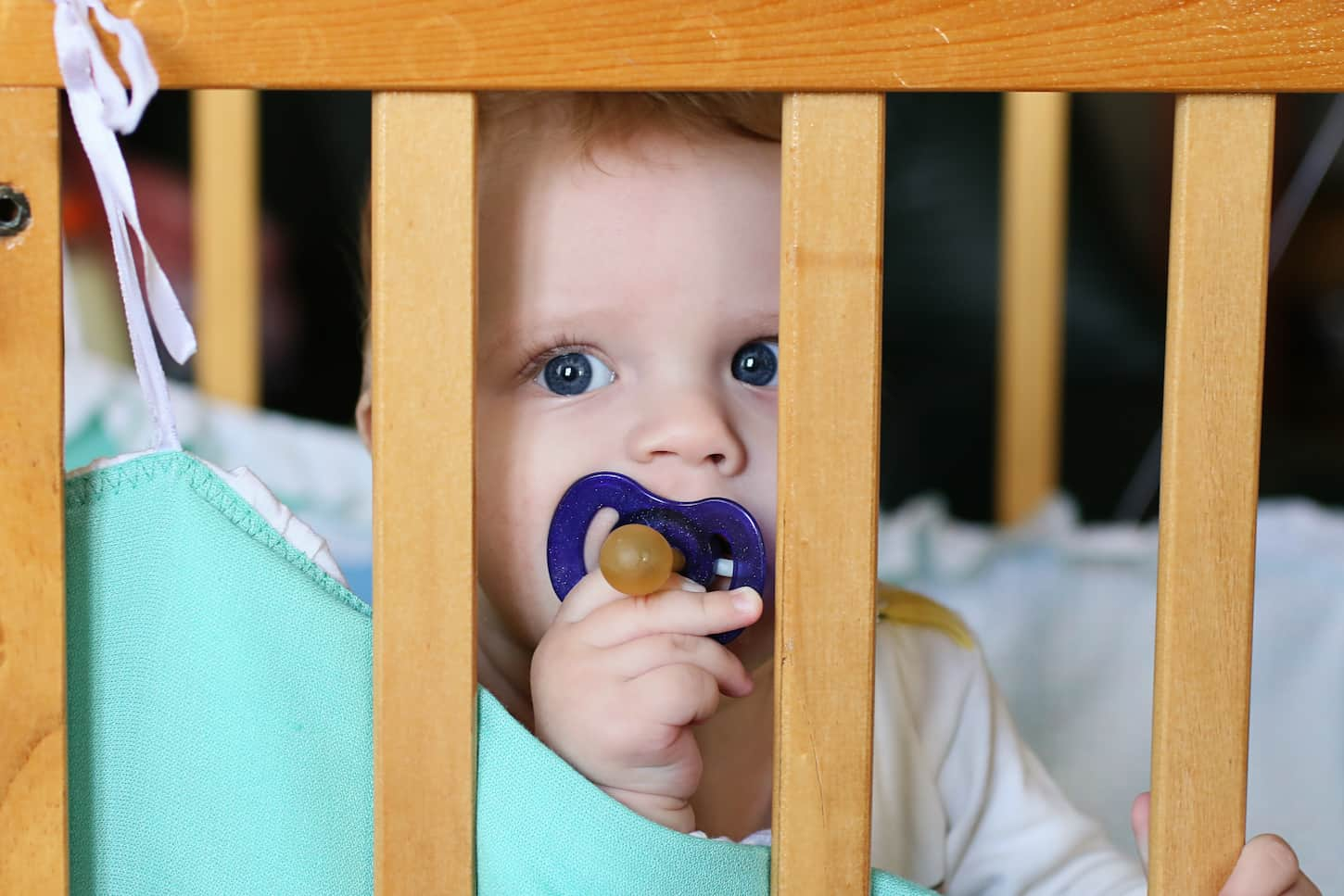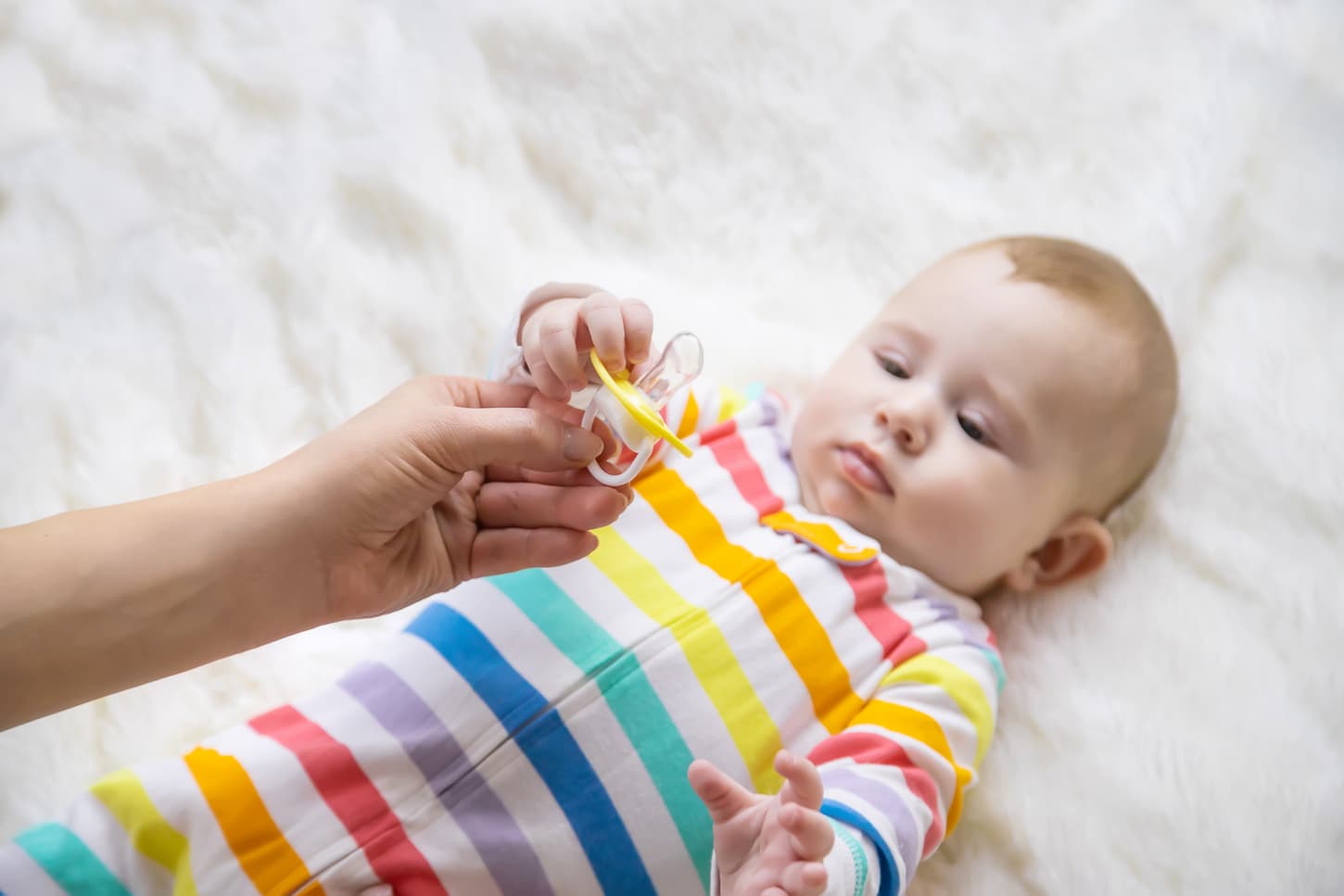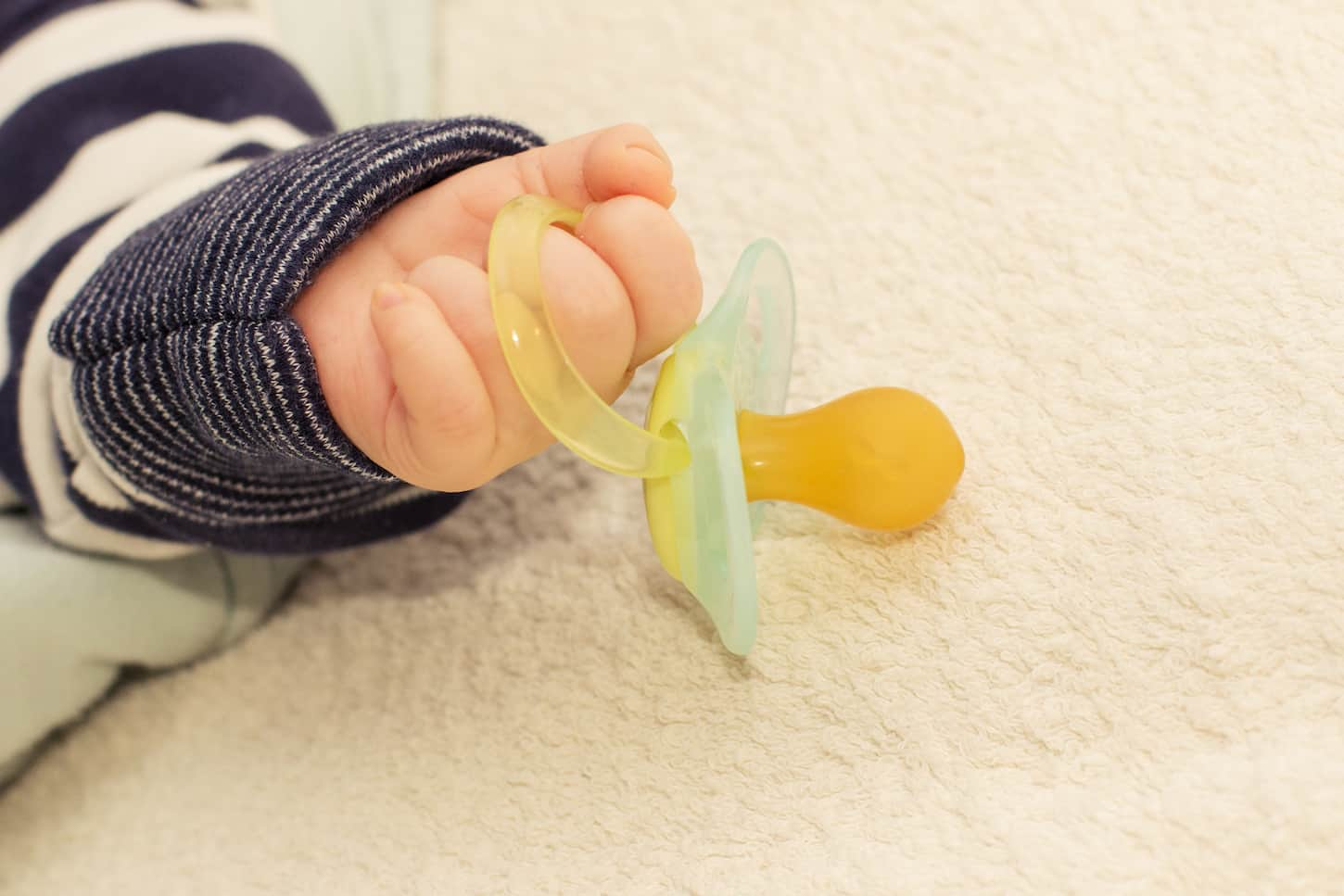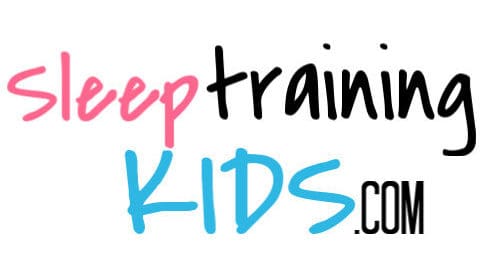Pacifiers are amazing. Full stop. They are a fantastic tool for parents to help relax their children. It helps to calm and soothe the child and provides you with some moments of peace and/or self-care as a parent. However, sometimes pacifier change becomes a significant issue.
Pacifiers will need to be changed when outgrown, due to hygiene issues, or if there are concerns with comfort or ease of use. Changing them out requires patience and working with your child over a period of time (from minutes to weeks) to swap one pacifier for another.
Ready to read more about pacifiers? Let’s make sure that your baby’s got the right one – or help you and your little one change it out for a better one if need be.

How Do You Get a Baby to Switch Pacifiers?
Getting your baby to switch pacifiers is going to depend on three factors.
- How old is your baby? Swapping pacifiers on younger babies can be much easier than for older toddlers.
- Is your baby willing to change pacifiers? Broken pacifiers tend to be more easily replaced than those that are still totally usable. At least, that’s how it’s gone in my experience as a mom and as a hospital nurse.
- Do you already have another pacifier they can use? Seriously. Make sure you’ve got one on hand, otherwise this is just research for later.
If your baby isn’t willing to try a new pacifier, then the change-out will either take more time or involve more tears (or screaming) until they accept the new pacifier. In some instances, like if the old pacifier is still a usable option, then the fighting may last as long as the old pacifier is visible.
So here are the steps for swapping out a pacifier.
- Make sure you’ve got a replacement binky in hand. Swapping it out doesn’t work unless you’ve got it.
- Put the new pacifier in your child’s hands. Let them play with it.
- Pop out the old pacifier and guide the new one into their mouth.
- Pocket the old pacifier – ideally without being seen.
- When they ask about the old pacifier (verbally or with gestures), let them know it’s gone. Then redirect them to the new pacifier.
You’ll have to do step 5 a lot, depending on your child. We used a sing-song voice and would just repeat (sometimes ad nauseum), “Uh oh, Old binky was gone. Where’s the new binky?” Our kids then thought it was a game of hide-and-go-find the new binky, which made them like it more.
And don’t forget – you can train your child to hold the pacifier in their mouth by gently tugging on it while they’re actively sucking on it. Sometimes the reverse psychology method actually works – and this is one of those rare times.
When Do You Need to Change a Pacifier?
All these steps will make your child an independent pacifier user. However, keep in mind that you will need to switch the pacifier if:
- The pacifier is not properly clean. Pacifiers shouldn’t be nasty. Go ahead and clean it. If it’s beyond cleaning, it’s not shameful to just replace the thing. We liked to keep a few spare pacifiers on hand for when we needed to clean one (or several).
- It is visibly damaged (especially on the part that your child sucks on). Broken and damaged pacifiers need to be replaced.
- If you feel like your child’s response towards the older pacifier is not good. If instead of making them calm, it is making them agitated, then it’s time to replace the pacifier.
Pro tip: you can totally clean your baby’s pacifier in the dishwasher. Double-check that the pacifier’s instructions say it’s dishwasher safe. But that’s how we always washed dirty binkies. Bonus points if you use a sanitize cycle.
If you don’t want to use the dishwasher, some soap, water, and air-drying are a great way to clean the pacifier, too.
Why Do Babies Reject Some Pacifiers?
Babies (and small children) reject pacifiers for a variety of reasons. These are the most common reasons I’ve seen as a mom, a nurse, and in talking to thousands of other parents about pacifiers.
Rejection #1: Pacifier is broken
If the pacifier is visibly broken, then a baby is most likely to reject it. In all of my years as both a mom and a nurse, I’ve never seen a baby who will take a pacifier that’s got a huge hole in the sucking part. It gets rejected. This is good because the huge holes get nasty fast.
I have seen children hang onto pacifiers with small holes or dents in them, though. Even so, they’re going to finish breaking and/or totally fail soon. So go ahead and replace it.
Rejection #2: Bad timing
Sometimes a baby spits out a binky simply due to bad timing. This can mean on a one-time rejection basis or it can become a more permanent “I’m never taking a pacifier and there’s nothing you can do to make me, mom!” kind of basis.
As a nurse, I learned a hard truth. Adults and parents are often overly quick to pop things into their child’s mouths. Oftentimes, it’s just the pacifier. Other times, it’s food. Just because a baby is crying doesn’t mean that sucking (or eating) is the only thing that can be done to help the child.
I met many children (while working as a nurse in a pediatric hospital) who developed significant eating disorders as small children because any time they made a noise – someone gave them something to eat.
Children might cry because of various other reasons too. The reasons could be tiredness, fatigue, or boredom. So explore other options. Don’t just keep jamming the pacifier (or food) back into their mouth.
On the flip side… another important note. I saw significantly fewer problems from children who were constantly given a pacifier compared to food. So if you’ve tried to find what’s wrong and you have no idea? Giving your child the pacifier again won’t hurt them. Just give them the autonomy to reject it again.
Rejection #3: The pacifier is the wrong size or shape
Children also tend to reject pacifiers of awkward-for-them sizes and shapes. Uncomfortable pacifiers are those that are either too big to fit in the mouth or too small so that it does not satisfy a child’s self-soothing via sucking needs.
What’s this mean? It means you may have to experiment with various sizes and shapes of pacifiers to find one that your child likes.
Pro tip: There are different sizes of pacifiers for any shape, style, or brand of pacifier.
- Size 0-6 months: this size is for children under six months of age.
- Size 6+ months: this size is for children over six months.
- Size 18+ months of age: this is a newer size of pacifier for older toddlers.
Find a few styles of pacifiers that you like (for the visible, outside-of-the-mouth style), and then try both sizes in each style. Odds are that your baby will find one they like. Don’t worry – we’ll talk more about the styles in a moment.
Rejection #4: Pacifier doesn’t feel good
Sometimes a baby just rejects a pacifier because it doesn’t feel good to them. You may (or may not) be able to figure out more than that. It could be because of low-quality silicon, rubber, or unsuitable size or shape that cause discomfort. Or it could be that your baby is just not having it.
Teething could be another reason why a binky doesn’t feel good. Teething may be a temporary issue with pacifiers or it may totally change how your child takes a pacifier.
I’ve found that, when a pacifier doesn’t feel good for a child, it’s best to put it aside for a few days (and wash it). Give them another one for the time being. You can try the original one again later.

Can Babies Use Different Pacifiers and Pacifier Styles?
Some babies will be fine using different pacifiers. Others will demand to use the same style and size of pacifier every time. And others will insist on using only one particular pacifier. It’s going to vary by child.
So let’s talk about the various styles that make up a pacifier.
Pacifier part #1: Pacifier nipple shape
The various pacifiers have differently shaped nipples. Nipple shapes include:
- Round at the end
- Cylindrical
- Orthodontic
- Flatter
Parents select most pacifiers after considering what their child likes and wants. However, there are generally different purposes for different types. Like, cylindrical nipples are suitable for children who are still breastfeeding. Its shape gives them a feeling similar to breastfeeding.
- Round at the end – these are generic pacifiers that rock as an all-purpose pacifier.
- Cylindrical – these pacifiers are supposed to mimic the shape and feeling (I don’t know who tested this) of breastfeeding.
- Orthodontic – these pacifiers are great for kids who are teething. Kids can suck on these without disturbing their gums or teeth.
- Flatter – this is yet another option for pacifiers that works for some children.
Consider what kind of pacifier it is – but know that your child may not agree with what the marketing slogans of the brand say.
My kids hated the cylindrical and round pacifiers – even since birth. But they all went right to the orthodontic pacifiers. Despite the fact that none of them got their first tooth until after a year old.
So don’t feel like the style is a constraint. Rather, it’s a good guideline to get you started. But always go with the rule of “whatever works best.”
Pacifier part #2: Pacifiers are affected by your child’s sucking pattern
Okay, so technically this isn’t part of the pacifier. But it’s related to the pacifier nipple and shape – but it’s your child’s natural sucking patterns.
Knowing this part of the pacifier will help you identify a winner from a pass in the pacifier department. Watch how your child sucks on the pacifier.
- If they take a single suck and then spit it out every time? They aren’t liking it.
- But if your child is sucking on it and not spitting it out? Potential winner right there.
It doesn’t have to be rocket science. But it is important enough to mention here. I mean, it got asked by new parents in the hospital. So I know someone else somewhere is wondering about it.
Pacifier part #3: Exterior aspects of the pacifier
Pacifier exteriors are still part of the overall design and style. There’s both the handle, the mouth guard so that your child doesn’t try to eat the pacifier and an option for a handle in most styles.
So some pacifiers come with rounded exteriors that don’t have a handle. Some have handles. Others have chains or stuffies attached to the handle. Then there are the green hospital pacifiers that let you stick your finger into the pacifier.
There are all sorts of designs. Kids will find some of the exteriors comforting and others downright annoying.
My kids didn’t like it when people stuck fingers into their pacifiers. They liked having a handle to hold onto while they sucked. Well, three of my four did. My second boy liked a pacifier that had a nub on the end that was pretty much worthless as a handle. But it was his favorite.
Do All Babies Need to Change Pacifiers?
Not all babies need to change pacifiers. Children will only need to change pacifiers when they outgrow or can no longer comfortably use their favorite pacifier.
Keep in mind, though, that some children will outgrow a pacifier but still want to use it. This is when it’s important to swap out the old, too-small pacifier for a properly sized one. The idea is if you can find an identical-looking pacifier that’s just a better size.
Even then, your child may be able to tell the difference. So you may need to get creative with how you swap them out.
But if your child just won’t swap up to the bigger size? Then do what you can. Weigh the pros and cons of binky graduation now versus waiting a bit.
My second son had a too-small binky that he wouldn’t give up until he was two. My pediatric dentist was fine with it, though, so we didn’t stress about it until it was binky graduation day.
So if your child won’t accept a larger, more appropriately-sized pacifier, be sure to talk to your child’s dentist. They may be able to give you some pointers – or, depending on the pacifier in question, just reassure you that it’s fine.

Best Pacifiers to Change To (according to my children)
If you can get your child to accept an orthodontic-approved pacifier, definitely go with that. We managed to get all of our children off the green, hospital-provided pacifiers pretty quickly. My husband didn’t like them – mostly because they give you such an awkward view into a sucking child’s mouth.
In any case, try to go for an orthodontic and dentist-approved pacifier. Of all of the pacifiers, they’re the best. They’re the least likely to have future teeth problems from prolonged sucking. Keep in mind, too, that most dental healthcare professionals will recommend that your baby stop using a pacifier by the age of 2-3 years old.
My kids’ dentist said three was the absolute upper limit for pacifier use, but he was very on board with our family rule of “no pacifiers after age 2.”
In any case, these are the pacifiers we used, loved, and my kids recommended by how much they used them. My kids LOVED the Phillips Avent brand of pacifiers. It’s the one brand that all four of them took. We sometimes found other brands they liked, but Avent was always the reliable option. And they’re usually decently priced on Amazon or in most local stores that have a baby section.
- Here’s the Phillips Avent orthodontic pacifier (on Amazon) they loved from 0-6 months of age.
- For 6-18-month-olds, here’s the same orthodontic, ultra-air pacifier by Phillips Avent (click here to see it on Amazon). Don’t want it in blue? That’s fine. It does come in other colors, like this version in pink.
- For 18 months plus, here’s the same orthodontic ultra-air pacifier (on Amazon).
I loved them because they were orthodontic, they allowed for airflow, and they had a handle. The little handle seriously makes life easier – especially if you’re willing to use a binky tether. You can shop binky tethers on Amazon here. Just make sure you get one that’s short enough that it’s not a choking hazard for your child. Be smart when using a tether – ideally, you should only use them if you’ve got an active eye on your baby.
Final Thoughts
Pacifiers are an amazing must for parents. There are many benefits of using a pacifier, like:
Reduces risk of SIDS: Many studies reveal that using a pacifier during the first year of age reduces the risk of sudden infant death syndrome (SIDS). The forward positioning of the tongue to suck the pacifier is the reason that saves the baby from obstruction and thus reducing the risk of SIDS.
Helps with thumb sucking: Pacifiers are a great alternative to thumb sucking. Pacifiers are easily replaceable or take-away-able (while thumbs are not). Therefore, they are a good alternative for preventing or replacing a thumb-sucking addiction. Additionally, thumb sucking also affects teeth formation and alignment, whereas the risk is less with pacifiers. Therefore, it is a better substitute for thumb sucking.
Increases comfort level: babies suck by instinct – it’s how they get food. And so it’s only natural that sucking on something brings them comfort and soothes them.
Little ones can locate and find their pacifier even when they are 6-7 months of age. They have a special attachment to their pacifiers. And that’s just fine. So make sure that you’ve got all of your parenting and sleep-related questions answered – feel free to share this article with another parent who’s been wondering about pacifiers.
Or if you’re wondering about the reality of sleep training with a pacifier, don’t fret. We’ve got you covered with this article on sleep training with a binky. Give that a read next.
